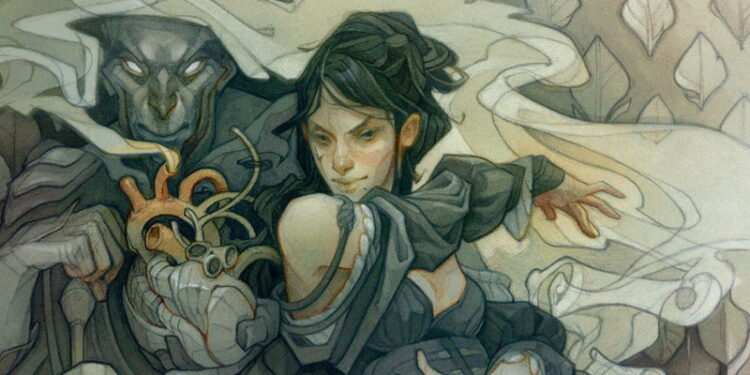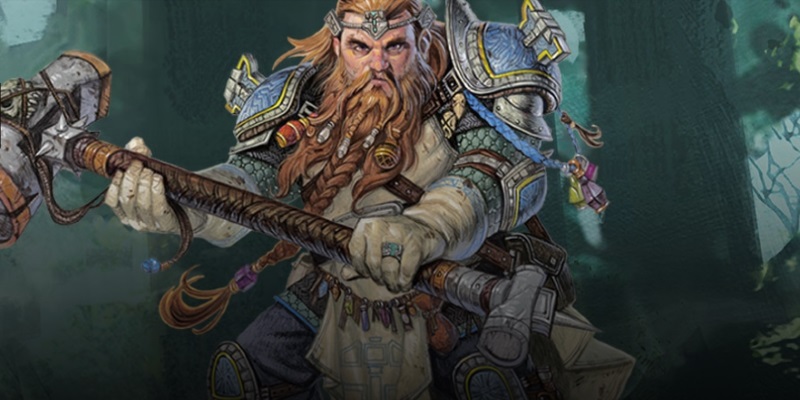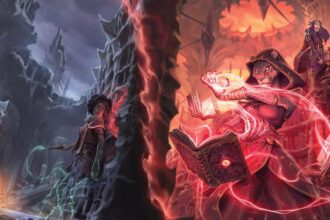
Okay, folks, I’m feeling good today, I think we’re finishing off who- or whatever Tasha has been cooking in that cauldron all this time. It’s the back half of Chapter 4, starting with Environmental Hazards. Let’s do this thing.
Part One | Part Two | Part Three | Part Four | Part Five | Part Six | Part Seven | Part Eight | Part Nine | Part Ten
Environmental Hazards
This is a huge expansion for exploration challenges, by introducing stuff that happens while you’re on the move through a region with one of seven different major phenomena (doot doo dee doo doot) in effect. They’re all presented in the form of 3-5 triggers. There’s also a list of generic triggers, helpful if you’re building your own new Environmental Hazard. If one of those happens and you decide that it’s the right time (the rules are phrased as “consider rolling when,” rather than anything even faintly more proscriptive), you roll d100 and consult the associated table for the effect.
The up-front problem with all of these: there’s nothing resembling difficulty guidance. What tier of play is most appropriate to any of these? Are some more tier-1 friendly, and others more tier-3 or higher? Should you plan to rescale damage, using the guidelines in Chapter 8 of the DMG?
Blessed Radiance is the only one where most of the effects are good for the PCs, or at least for humanoids. There’s a strong assumption that aberrations, fiends, or undead are part of most of those encounters – two out of four triggers, and four of the seventeen effects, require them. I don’t know that I’ve ever seen an encounter staged somewhere that the environment was ambiently beneficial. I think you’d want to tilt the encounter against the PCs to a considerable degree, if a challenging fight was part of the idea.
One way of using this that could be particularly fun is against endless respawning enemies. You tell the players in advance that their only way out of the fight alive is Divine Intervention (the 96-100 result). They have to endure until that happens. Instead of rolling d100 when a trigger occurs, you roll… let’s say 2d20 and add the result to sum of previous rolls (your first roll is +0). PCs get a steady series of Good Things happening to sustain them against all of this badness. Obviously, you treat the 96-100 result as 96+ instead.
Same structure, minor variation: a paladin needs to prove that they are worthy of a holy avenger sword, or a character wants a permanent angelic blessing to protect them from necrotic energy. Go fight until you add up to a 91+.
Far Realm is, naturally enough, your Mythos intrusion. It gets a lot more interesting if there’s a Great Old One warlock in the party, as one of the suggested triggers specifies them. The other two triggers and all of the effects have a much more exploration-based thrust to them. What I see here is a cogent structure for running a Call of Cthulhu-style haunted house – I’d just add “the PCs go into a new room” as a trigger.
Since I’m covering “other ways to use this content,” oh man, this hazard has a doozy. Start with a setting where plane shift stops working for some reason, but you still need to get to a particular plane. Solution? Roll a 96+ in a Far Realm environment, and survive the 10d10 psychic damage (maybe you want to add a save-for-half thing to that). If I’m playing a Sage, warlock, or wizard, learning how to get the world to generate magical effects for me by jumping through hoops is a deeply appealing type of secret to uncover.
Haunted is the very next one, and these triggers and effects are more classic haunted house than a CoC haunted house (not that CoC doesn’t also use classic hauntings). I like what’s here as triggers and effects, though there’s enough of a sense of progress from lower rolls to higher rolls that even risking the high rolls happening early and getting followed by an anticlimactic lower roll seems like a strange choice. You probably also want to avoid repeats. I read this more as “you have a task to finish in this area – get it done before the really bad stuff happens.”
Having said that all of that, I loved the 7th Guest video game and this gives me that vibe. I don’t know how you look at the 96-100 effect and don’t have those mists transport you to Ravenloft, though!
Infested is just gross. In my gaming groups, I would lose friends and possibly my marriage for using this, because it’s just crawling (sorry) with phobias. This is directly related to why chasme demons don’t show up much in my games, I’m just saying. Having said that, this one also speaks to me less, because disgust is harder for me to work with than dread. There just aren’t as many stories that come immediately to my mind here.
Mirror zone brings the nerra of 3.x and 4e to mind. I’d want to run this in a Versailles-like palace that you’re not allowed to leave (other than touring the gardens) for a royally-mandated long “vacation.” This one has less of a sense of progression. If I wanted that, I’d change the table to end in getting sucked into the Plane of Mirrors or summoning a nerra boss.
Psychic resonance would be cool for a big effect surrounding an Aberrant Mind’s psychic awakening (or Psi Warrior or Soulknife), or a big ritual effect by mind flayers, or some conjunction with the Astral Plane. The 95-100 effect on this one is wild, and even a location that had a major psychic resonance a long time ago would be a fascinating adventure site.
Unraveling magic is an area of magic falling apart. If there’s a fight on, you’re all but guaranteed to see a lot of trigger events occur, unless the PCs are actively avoiding them. The effects are within the bounds of normal (?) wild magic weirdness, and the 96-100 effect is absolutely big enough to be the goal of a progression adventure. There’s a healthy mix of beneficial and dangerous effects here.
My only issue here is the 06-10 effect, because it shuts off a bunch of other table effects for an hour of game time. No triggers and no effects for an hour, to say nothing of locking out some or all of the party members using their core gameplay. A normal antimagic field isn’t a problem, really, but it’s a 10-ft sphere, which is probably a lot smaller than whatever you interpret “region” to mean.
Magical Phenomena
(doot doo dee doo)
Of the many things that set 4e apart, one thing is the encounter-changing magical hazards and effects. This section doesn’t directly lift from the 4e DMG2 (…in the way that I might have wished… that book is amazing), but it offers a bunch of interesting things that will be a major twist to any encounter. One of the things about those twists, though, is that they’re (presumably?) increasing the difficulty of the encounter for the players. By how much, do you think? Should we expect to rescale damage values to use these at tier 1 or tier 4?
Eldritch storms come in four different variations: slashing, fire, necrotic, and cold damage types. The damage and duration of the storms vary, and they have some additional effects, but all in all these are fairly straightforward. Since you might be resolving these as an additional step in combat, or constantly in the course of an exploration challenge, simplicity is a virtue. The necrotic tempest is the outlier here, for dealing damage only once per minute rather than once per round at the start of your turn.
Emotional echoes attempt to overwhelm creatures with a single emotion and the compulsion to express it. Eight emotions are detailed, though there’s nothing at all to making your own. I… might be the wrong audience for this one? It doesn’t super speak to me. (Usually when I say something like that, I wind up putting that idea or something extremely similar into a game in the next few weeks, without realizing I’ve done it.)
Enchanted springs are your classic magical springs that offer interesting effects. Whether you need to bathe in, drink, or touch the water varies; not all of them have mechanically-significant effects. You can’t take vials of the water away unless the spring’s guardian blesses the vial, which is a fine solution to an age-old player-rationale question. I guess I’m surprised that only one spring is healing of any sort; I’d kind of like to see a limited-use healing spring that you might fight near? (I can write it myself, of course.)
Magic mushrooms take as much inspiration from Alice in Wonderland as psilocybin. I appreciate that the absolute worst available effect is some minor embarrassment or a reduce effect you weren’t looking for; the flavor text hints at dangers more in line with death cap or destroying angel mushrooms. The beneficial effects range very high indeed. For the the Underdark or Feywild, I think these make for a great way to vary things up.
Mimic colonies turn the weirdness dial up to 11. It’s D&D exploring the implications of what is very much a D&D thing. Mimics are in all kinds of fantasy dungeon-crawling games now (hi, Dark Souls!), but they started with D&D, and it seems like only D&D wants to keep changing the shape (heh) of the idea. I like what’s here, all the more because it does have challenge rating mechanics.
Primal fruit has a lot of the same “random potion-like benefit” sense as enchanted springs and magic mushrooms. I’m fine with a lot of different ways to hand out minor-to-major power-ups or free healing. It’s a narrative classic for a reason! Most of the primal fruit effects include drawbacks of one kind or another, and that’s a nice touch.
That said? You do not want PC lycanthropy in your game, at least not using the Monster Manual’s rules. I can’t emphasize this strongly enough.
Unearthly roads seem to be inspired by a mix of seven-league boots and, maybe, that tunnel scene in Willy Wonka and the Chocolate Factory? They have key-like requirements, similar to portal keys in Sigil. Anyway, they move you 21 miles when you walk one actual mile. I can think of a lot of LARPs that are wishing they had come up with this specific idea, as a lesser form of teleportation to bring distant adventure locations closer to their main game settlement.
Natural Hazards
This section includes avalanches, falling into water (as in, from a great height), and falling onto a creature (flying druids Wild Shaping into whales or other large animals is the Oh No, Not Again of D&D since… forever). I don’t have a lot of specific commentary about those, except that I really like the dual initiative count mechanic of avalanches. It’s trying to mitigate the stop-motion-y nature of action in rounds. The effect attached to it is such that you’re not excessively punished for not being able to take actions as often as the avalanche does.
Finally, there’s a table of natural hazards that you can resolve using the standard mechanics of a spell effect. Treating spells as taglines that you can use for other stuff is pretty well universal in LARPing, so it’s nice to see D&D use something similar here. I also like this table as a checklist of horrible things to do to the players in exploration challenges or in the midst of boss fights. None of them are outside the ideas a reasonable person might have if asked to create mechanics for (this random thing), but reminding me how much I’ll enjoy putting my players in the path of a pyroclastic flow? Chef’s kiss.
Heck, I just like saying “pyroclastic flow.”
(Making it obvious that I live about as far as it is possible to live from volcanic activity.)
Puzzles
The chapter, and for that matter the book, ends with puzzles. I’m not going into any depth on these, because I don’t think it’ll be that helpful to you as a reader, spoilers or no. You probably have a strong opinion on puzzles in tabletop gaming already, and the odds that I can shift it even 1% in any direction are nil. That’s okay! Personally I like puzzles and I am completely comfortable with puzzles challenging the player rather than the character. I don’t want to insist on my character’s stats helping or hindering me in puzzle solving because that makes it less convenient for the DM to entertain me. Which I try not to do!
Conclusion
I’ve had criticisms of a few parts of Tasha’s Cauldron of Everything along the way, but overall? I think this book accomplished what it set out to do. Power creep isn’t out of control by any means, though I think the cleric domains are toeing that line awful hard. In other classes – sorcerer and warlock especially – it seems like WotC has found their groove in a way that the PH subclasses sorely lack. For my money, Tasha’s is a very useful book of player options and DM-facing content, and I’m happy that we probably won’t have another major content-expanding book until 2023-ish. (Judging by the three core books in 2014, XGTE in 2017, and TCOE in 2020.)
I hope you’ve enjoyed this series!
And my final word on the matter:
phenomenon
(doot doo dee doo doot…)



